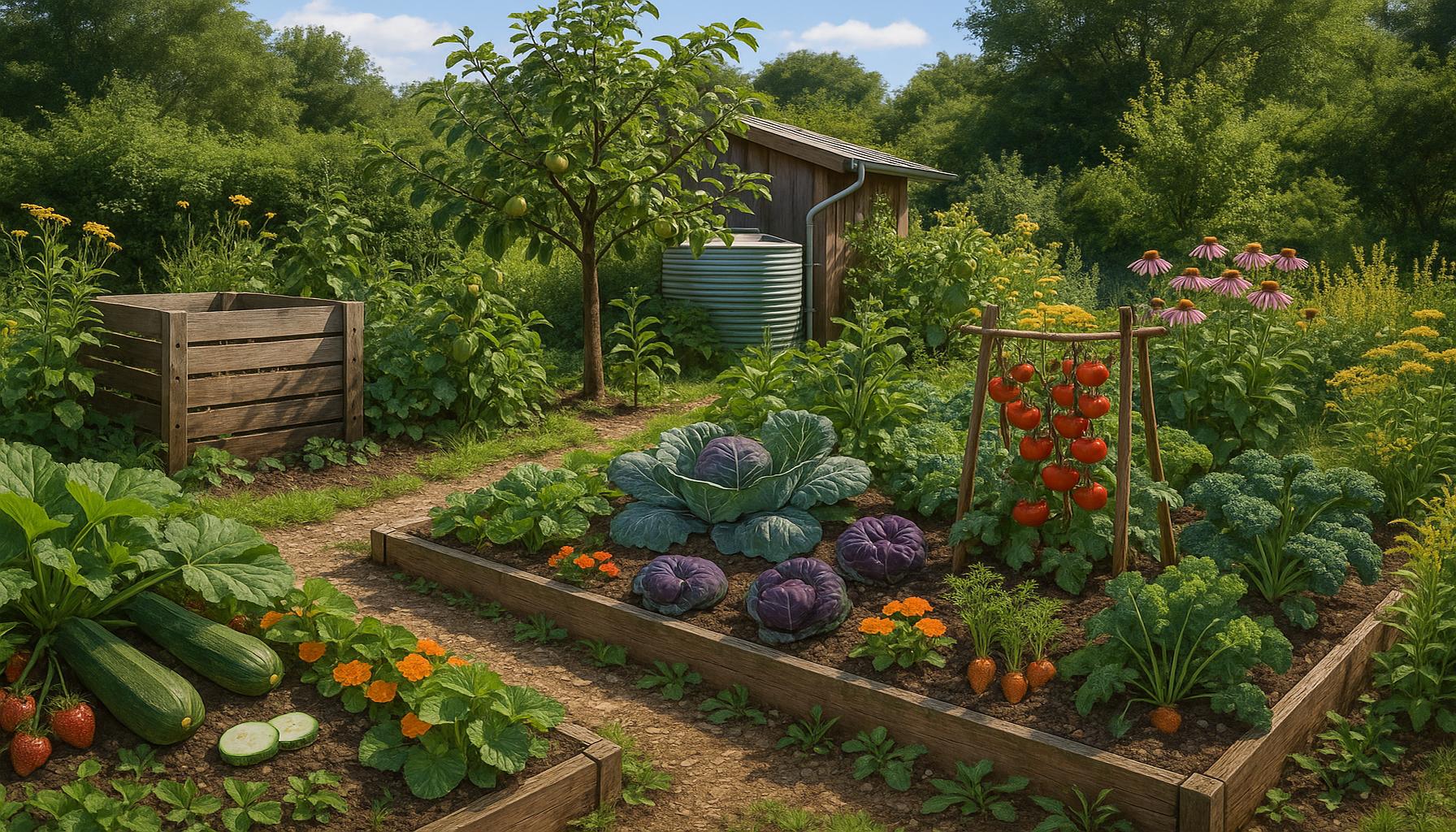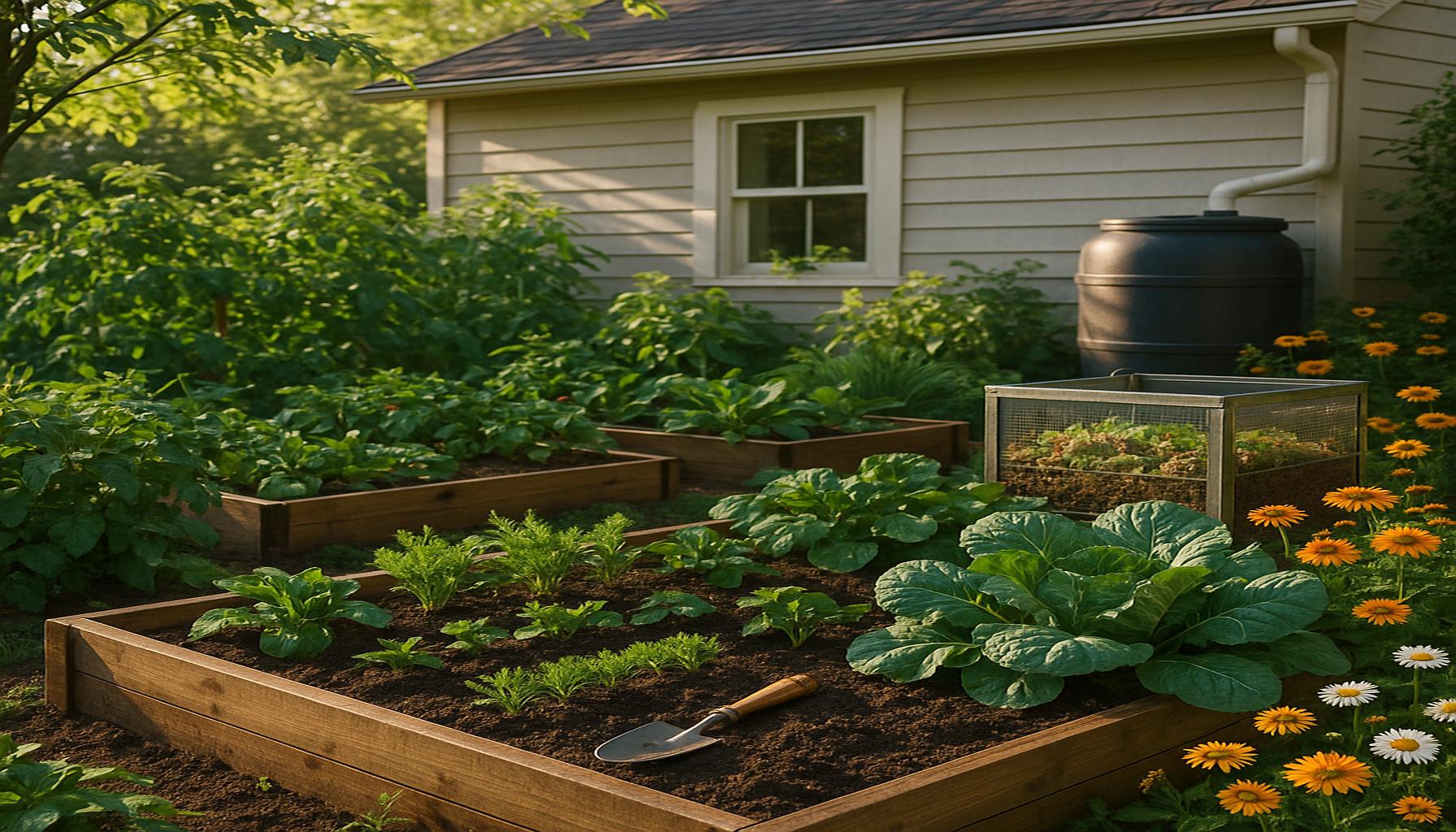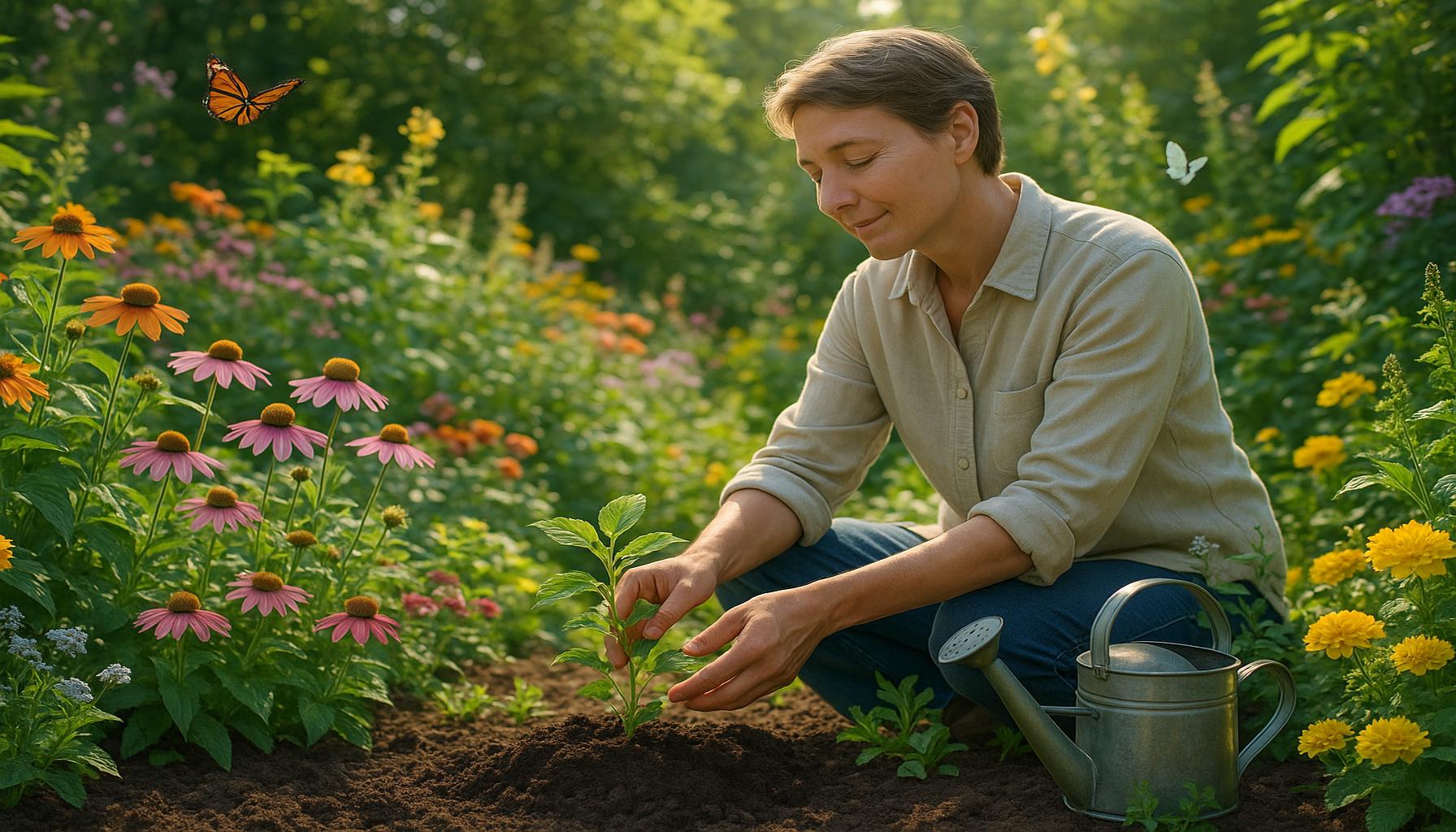Permaculture Techniques: How to Create a Self-Sustaining Garden that Integrates with the Ecosystem

Understanding the Principles of Permaculture
Imagine stepping into a garden that not only provides an array of delicious fruits and vegetables but also flourishes in beautiful synchrony with the surrounding environment. This creative vision embodies the philosophy of permaculture, a term derived from “permanent agriculture” and “permanent culture.” Through the integration of innovative practices, permaculture fosters resilient ecosystems that promote biodiversity, conserve vital resources, and significantly improve soil health.
At its core, permaculture transcends the mere act of growing food; it is about nurturing a deep, respectful relationship with our surroundings. To create a thriving permaculture garden, consider the following pivotal components:
- Companion planting: This technique involves pairing plants that mutually benefit one another. For example, the classic combination of tomatoes and basil not only enhances the flavors of both but also deters pests. The marigold flower is another excellent companion, as it attracts beneficial insects while repelling harmful pests.
- Mulching: Applying organic material such as straw, wood chips, or grass clippings around plants helps retain soil moisture and suppress weeds. Additionally, as the mulch decomposes, it enriches the soil, providing essential nutrients to your plants.
- Composting: This practice of recycling organic waste—kitchen scraps, garden leftovers, and even leaves—creates nutrient-rich soil amendments. Composting reduces landfill waste and transforms what would be trash into valuable food for your garden.
- Water management: Effective water management strategies, such as rainwater harvesting, not only preserve water resources but also reduce dependence on municipal water systems. Systems can be as simple as collecting rainwater in barrels or implementing swales to enhance groundwater recharge on your property.
By weaving together these methods in a thoughtful way, your garden can evolve into a productive haven that welcomes beneficial insects, birds, and other wildlife. In today’s world, where ecological sustainability is more crucial than ever, implementing permaculture techniques can significantly minimize your ecological footprint and yield numerous benefits.
As we delve deeper into the principles and practical applications of permaculture, you’ll discover strategies to transform even the smallest plot of land into a self-sustaining paradise. From creating a vegetable patch to planting native flowers for pollinators, the journey towards a healthy lifestyle intertwined with nature begins here. Embrace the challenge, and learn how to cultivate not just food, but a thriving ecosystem that enriches your life and the environment.
DISCOVER MORE: Click here to dive into the world of musical composition
Innovative Strategies for Sustainable Gardening
Creating a self-sustaining garden that seamlessly integrates with its ecosystem necessitates a blend of creativity and strategic thinking. The essence of permaculture techniques lies in mimicking natural systems, allowing your garden to flourish while reducing reliance on artificial inputs. Here are some innovative strategies to cultivate a productive and harmonious garden:
- Polyculture: Instead of planting a single type of crop in a designated area, polyculture promotes the idea of planting multiple species together. This diversity enhances resilience against pests and diseases while imitating natural ecosystems. For instance, growing a mix of fruits, vegetables, and herbs not only creates a visual tapestry but also encourages beneficial interactions among the plants. This method can lead to higher yields, maximizing harvest potential while minimizing the risks associated with monoculture.
- Zone planning: A fundamental tenet of permaculture is the concept of zoning, which involves strategically arranging your garden according to the amount of care, interference, and attention required by each plant type. Zones are categorized from 0 (your home) to 5 (wilderness), allowing you to place high-maintenance crops near your home for easy access and monitoring, while leaving less-attended areas to more resilient plants. This design plan not only enhances efficiency but also encourages prioritizing spaces for biodiversity.
- Guild planting: Guilds are plant communities that are designed to work synergistically to support each other’s growth. By combining trees, shrubs, and herbaceous plants into a cohesive unit, you can create microclimates that offer protection from extreme weather, enhanced water retention, and increased nutrient cycling. For example, a fruit tree guild might consist of a fruit tree, nitrogen-fixing plants, ground cover like strawberries, and dynamic accumulators that gather nutrients from deeper soil layers.
- Forest gardening: Inspired by naturally occurring forests, forest gardening incorporates layers of vegetation to create a multi-tiered system. This includes tall canopy trees, understory trees, shrubs, herbaceous crops, and ground cover. This design not only maximizes space and yields but also promotes biodiversity and encourages wildlife. Implementing a forest garden can lead to a sustainable habitat that yields delicious produce while contributing to ecological health.
By exploring these permaculture techniques, gardeners can foster a more resilient and diversified ecosystem while contributing to environmental preservation. As resources grow scarcer, the integration of these practices can lead to significant improvements in sustainability. Adopting such innovative strategies, even on the smallest urban plot, allows individuals to reconnect with nature while cultivating a self-sustaining garden that produces food, nurtures wildlife, and enriches the local environment.
In the upcoming sections, we will further unravel the intricacies of these techniques, providing insights and practical examples tailored to any aspiring permaculturist eager to leave a positive impact on their surroundings.
Permaculture Techniques: How to Create a Self-Sustaining Garden that Integrates with the Ecosystem
Creating a self-sustaining garden through permaculture techniques begins with an understanding of ecological principles. By observing natural systems, gardeners can design their space to mimic these ecosystems, leading to enhanced biodiversity and sustainable yields. One key element in permaculture is companion planting, where specific plants are combined to promote symbiosis. For instance, planting tomatoes alongside basil not only maximizes space but also enhances flavor and deters pests, demonstrating an effortless integration within the ecosystem.
Another essential technique is the use of permaculture zones. This concept involves organizing the garden based on the frequency of human interaction and the specific needs of plants. Zone 1, close to the house, can serve for herbs and salad greens, while Zone 3 can accommodate fruit trees. Understanding this placement results in less resource use and maximizes energy efficiency. By creating a garden that requires minimal external inputs, gardeners cultivate resilience against pests and diseases.
Incorporating mulching and cover cropping are also effective strategies in maintaining soil health. Mulching suppresses weeds and retains moisture, while cover crops improve soil structure and fertility. Together, these practices contribute to a self-sustaining garden that continually builds upon its own ecological functionality. By exploring these innovative techniques, readers can transform their gardening practices into a holistic system that not only nurtures plants but also fosters an abundant ecosystem.
| Advantages | Description |
|---|---|
| Increased Biodiversity | Encouraging a variety of plants promotes a balanced ecosystem. |
| Enhanced Soil Health | Techniques like mulching and cover cropping help in maintaining soil structure and fertility. |
By understanding and implementing these principles and techniques, gardeners can create a self-sustaining ecosystem that nourishes not only the plants but also the practitioners involved. This integration fosters a deeper connection to nature, encourages environmental stewardship, and promotes sustainable living practices. Taking the next steps towards permaculture could be the gateway to a flourishing and resilient garden.
DISCOVER MORE: Click here to learn about the evolution of digital art
Building Soil Health and Water Management
A healthy, self-sustaining garden begins with fertile soil and effective water management, both of which are integral to permaculture techniques. By prioritizing these elements, gardeners can create resilient ecosystems that support plant growth and encourage biodiversity. Here are several essential strategies to enhance soil health and manage water in your permaculture garden:
- Composting: Composting transforms kitchen scraps and yard waste into rich, nutrient-dense soil amendments. By breaking down organic materials, composting replenishes essential nutrients in the soil, enhances microbial activity, and improves the overall structure of garden beds. Starting a compost bin or pile can be as simple as creating a designated area to combine green materials (like vegetable peels) with brown materials (such as dried leaves and cardboard). Over time, you will produce a valuable resource that reduces waste and nourishes your garden.
- Mulching: Implementing a layer of organic mulch, such as straw, wood chips, or bark, serves multiple purposes. It suppresses weeds, retains moisture, and regulates soil temperature. Additionally, as mulch breaks down, it is incorporated into the soil, further enriching it with organic matter. Certain types of mulch, like fallen leaves or grass clippings, also provide habitat for beneficial organisms, forming a mini-ecosystem right at your feet.
- Cover cropping: Planting cover crops during the off-season or between main crops is an effective way to build soil health and minimize erosion. Cover crops such as clover, vetch, or rye not only prevent soil depletion but also fix nitrogen back into the soil, promoting fertility. These plants can be turned back into the soil before planting your main crops, enriching it with additional organic matter and nutrients.
- Water harvesting: Efficient water management is crucial in sustainable gardening. Techniques such as rainwater harvesting can maximize water availability while minimizing reliance on municipal water sources. By installing rain barrels to collect runoff from rooftops, you can capture significant amounts of rainwater for later use. Implementing swales—contoured trenches dug into the landscape—can help direct and conserve water, allowing it to seep into the soil effectively while reducing runoff.
- Drip irrigation: Instead of traditional overhead watering methods, consider using drip irrigation systems. These systems deliver water directly to the root zones of plants, reducing evaporation and optimizing water usage. By employing a drip system, you can ensure your plants receive adequate moisture without wastage, making your garden more water-efficient, especially during dry spells.
By focusing on soil health and effective water management, gardeners can create a thriving, self-sustaining ecosystem that supports plant growth and encourages beneficial wildlife. As we witness the increasing effects of climate change and resource depletion, the adoption of these permaculture techniques becomes ever more crucial. Understanding how to build rich, healthy soils and manage water sustainably lays the foundation for a resilient garden, capable of withstanding environmental challenges while contributing positively to the ecosystem.
Our next section will explore more techniques that integrate plant and animal life within permaculture systems, revealing the dynamic relationships that can flourish in a well-designed self-sustaining garden.
DIVE DEEPER: Click here to discover the evolution of crafting
Conclusion
Embracing permaculture techniques offers an innovative path toward creating a self-sustaining garden that harmonizes with the surrounding ecosystem. By utilizing methods such as composting, mulching, cover cropping, water harvesting, and drip irrigation, gardeners can cultivate a thriving environment that not only meets their needs but also fosters biodiversity. These strategies are not merely gardening practices; they represent a lifestyle choice that emphasizes sustainability, stewardship, and resilience.
The importance of building soil health and implementing effective water management cannot be overstated. As the impacts of climate change and urbanization intensify, the demand for sustainable practices becomes more urgent. Gardeners equipped with this knowledge can mitigate the effects of resource depletion while enhancing the health of our planet. By nurturing both soil and water, we lay the groundwork for robust gardens that sustain flora and fauna alike and contribute to a healthier ecosystem.
As you embark on or expand your own permaculture journey, consider the relationships among plants, animals, and the local environment. A well-designed self-sustaining garden not only produces food but creates an ecosystem that thrives on natural synergy. By adopting these principles, knowledge, and techniques, you are taking steps toward a more sustainable future for yourself, your community, and the Earth. Your garden can become a beacon of resilience, demonstrating the power of nature and human creativity in achieving harmony with the environment.
As you explore further, consider researching additional permaculture techniques that promote biodiversity, such as companion planting, agroforestry, or integrating small livestock. Each of these approaches can enhance the resilience of your garden and cultivate a deeper connection to the natural world.


